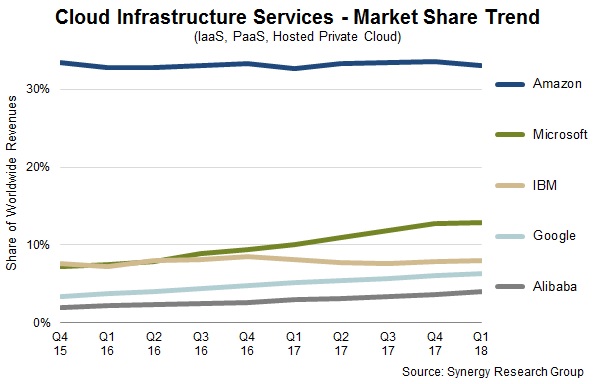
Cloud is driving sustained revenue growth for the major infrastructure service providers, a flurry of Q1 earnings reports shows.
A still-dominant Amazon took 33 percent of the cloud infrastructure services market – powering the company to analyst-beating profits, while Microsoft reported impressive Azure revenue growth of 93 percent, on market share of 13 percent.
IBM took eight percent of the market, Google six percent and Alibaba four percent, according to market share analysis based on Q1 results data by Synergy.
Amazon blasted through quarterly earnings estimates yesterday, posting a fourth straight quarter’s growth in net profit, boosted by a 28 percent sales increase. The company also announced a string of new enterprise customers moving to Amazon Web Services (AWS) during the quarter.
Jeff Bezos, Amazon founder and CEO, said: “AWS had the unusual advantage of a seven-year head start before facing like-minded competition, and the team has never slowed down.”
He added: “As a result, the AWS services are by far the most evolved and most functionality-rich. AWS lets developers do more and be nimbler, and it continues to get even better every day. That’s why you’re seeing this remarkable acceleration in AWS growth, now for two quarters in a row.”
Amazon reported first-quarter net income of $513 million on $29.13 billion in revenue.
Everyone Wants Cloud
For for the second successive quarter the market growth rate in cloud services use has actually increased substantially, analysis from Synergy shared with Computer Business Review shows, with growth jumping to an impressive 51 percent year-on-year, as cloud migration shows no sign of slowing.
“Cloud growth in the last two quarters really has been quite exceptional,” said John Dinsdale, a Chief Analyst and Research Director at Synergy Research Group.
He added: “Normal market development cycles should result in growth rates that slowly diminish – and that is what we saw in late 2016 and through most of 2017. But the growth rate jumped by three percentage points in Q4 and by another five in Q1. That is good news for the leading cloud providers, whose historically high levels of capex are helping to ensure that they are the main beneficiaries of that exceptional market growth.”

See also: Up in the Cloud: Why Proactivity is Vital When it Comes to Availability






